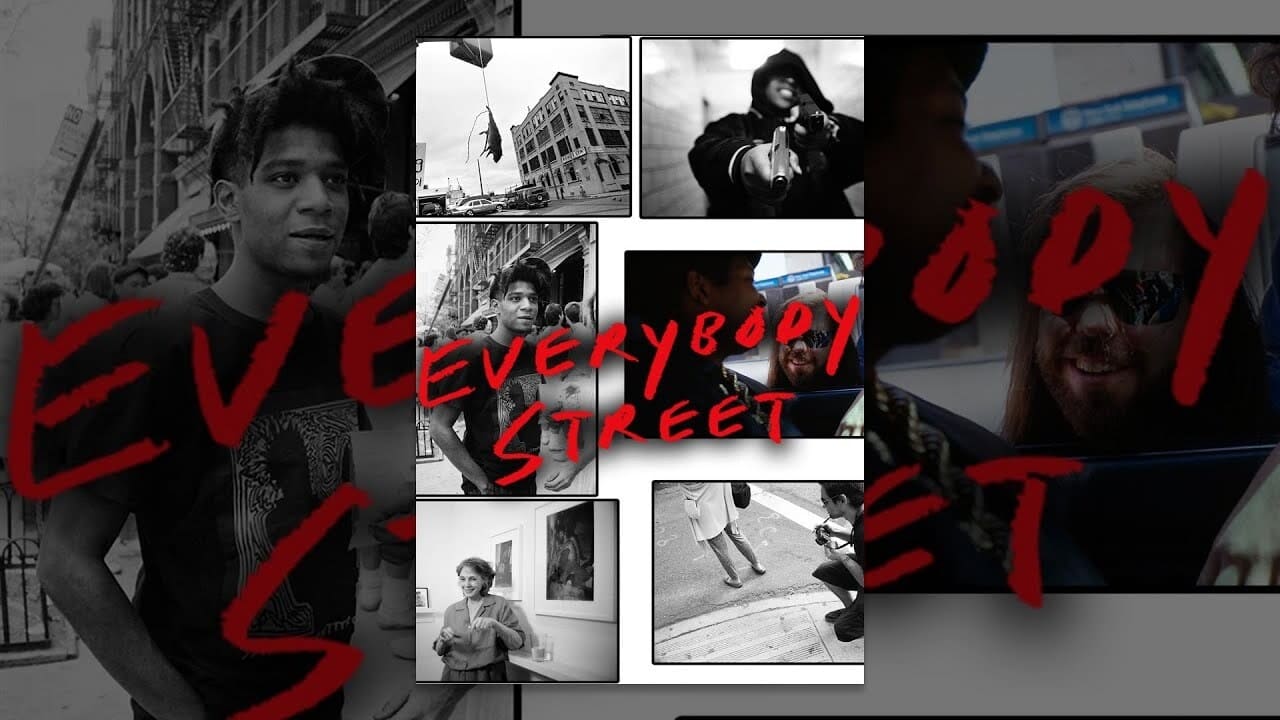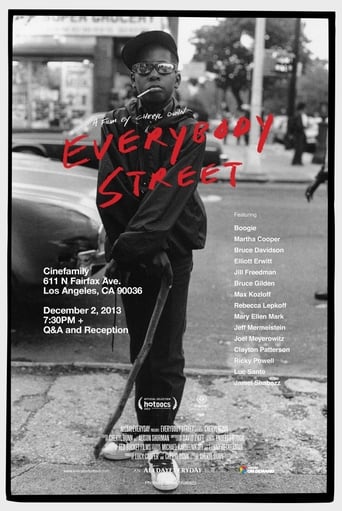

Entertaining from beginning to end, it maintains the spirit of the franchise while establishing it's own seal with a fun cast
... View MoreIt isn't all that great, actually. Really cheesy and very predicable of how certain scenes are gonna turn play out. However, I guess that's the charm of it all, because I would consider this one of my guilty pleasures.
... View MoreThis is a must-see and one of the best documentaries - and films - of this year.
... View MoreOne of the best movies of the year! Incredible from the beginning to the end.
... View MoreThrough its summary exploration of the lives and works of 13 prominent New York City street photographers, Cheryl Dunn's Everybody Street manages to portray the creativity and passion of the medium of street photography and its artists within the gargantuan and chaotic context that is the New York City street. The documentary explores the photographer's motivations and insights on various issues as well as artistic creation process of each of the 13. In doing so the film can pose and answer several questions/issues that greatly impact the street photography community. Stunning and unique visuals are present throughout the entirety of the film, found both in the selected works of the individual photographers shown throughout the documentary and within the visually impressive shots that compose most of the film. The selection of visuals from the works of the photographers allows Dunn to give the impression of visually dynamic interviews, despite them being rather static, creating for interviews that are exciting and engaging. Furthermore, the use of the photographer's own photos in conjunction with their spoken interviews creates a sense of intimacy with the photographers and their work, especially when describing the ways in which they began and the experiences they've had while pursuing the medium. This intimacy serves to create a further sense of humanity within the photographers themselves, mirroring a key goal of street photography common among the photographers, capturing the humanity among the crowd. Visually the documentary is also impressive within its own composition and choices of color grading, editing and medium selection. To mimic the visual styles of commonly used camera film types the filmmakers utilize various editing techniques that create stylistically interesting shots. These techniques include the intentional vignetting to mimic the effect of some camera lenses, manipulation of white balance, usage of colorization consistent with various film types and the application of film grain in digital shots and the occasional usage of a 16mm black and white film camera. These stylistic emulations of film within the digitally captured portions of the film serve to connect the piece visually and tonally to the tools and period within which many of the interviewed photographers worked, prospered and started. The usage of these techniques and the usage of the 16mm camera allows the documentary to achieve a certain feeling of authenticity and adds to the overall artistic merits of the work in of itself. Everybody Street also makes excellent usage of aural elements throughout the film to create an immersing and interesting ambiance that helps the movie keep pace, and stay engaging. One such aural element can be seen within the film's usage of era and genre appropriate music for the different time periods and cultural contexts discussed within the work by the photographers. The music used adds to the stylistic atmosphere of virtually every shot within the work, regardless if the shot is an interview or more active shot, or whether the music is simple instrumentals or stronger Hip-pop tracks. The music used also serves to help set tone within certain portions of interviews or to give further insight to the personalities of the 13 photographers featured. The second aural element used throughout the film is the inclusion of ambient environmental sounds, such as the sounds of traffic, people etc. in shots that normally would not have them. In doing so the filmmakers create another stylistic element that references and attempts to incorporate aspects of street photography within the film. The most striking, memorable and important portions of the film are the tonally candid reviews of the 13 individual photographers. Each interview consists of a static, traditional interview wherein the photographer establishes their journey and growth as photographers and explain past works and experiences. This portion is followed by a more active interview section, where the photographer is shown actively creating and capturing moments. Both serve to give important insight to the personalities of the photographers, giving reason to their different style, method, and ideals. This section is also key to understanding the small nuances within the method of each different photographer, ranging from their choice of digital vs. film, their interaction with their subjects, their choice of subject and many other small nuances that make each photographer unique within their own methods. Furthermore, in conjunction these two portions of the interview allow for a humanization and characterization of the photographers and their work. This humanization comes from the allowed appreciation of the reasoning and history within their method and choice in subject. This reasoning is essential in understanding what street photography is, and creates the foundation from which the audience can more easily interpret the act of capturing, and understand the art form. The primary weakness of the film is its lack of depth, concerning the exploration of each of the photographers. While the filmmakers do heavily intertwine visual and spoken elements to create information dense sections, I feel the lack of particular focus and usage of many photographers hinders the films ability to provide a better experience in learning about the photographers themselves. Despite this I do believe this is also a large strength of the film as It allows the piece to be highly effective in answering the questions it indirectly or directly poses. The photographers give excellent insight into how they view the medium, and see the issues that concern their work such as privacy concerns, arguments over digital and film, and most importantly what the meaning and best form of street photography. Having 13 different subjects, creates an excellent diversity of thought, and gives the viewers the ability to source their conclusions from many different experts.To conclude, I find that Everybody Street is an amazing film both stylistically and content wise. Its diversity of thought, amazing visuals, and insight make Everybody Street essential to contemplating and understanding the deeper implications of the dynamics between the crowd, the humanity found within it and the photographer that attempts to capture it all.
... View MoreCheryl Dunn's gorgeous and passionate ode to street photography is a truly wonderful film with a soundtrack that throbs to the beat of New York City past. Featuring interviews with over a dozen shooters, including the brilliant Elliott Erwitt, Mary Ellen Mark, and Joel Meyerowitz, the film is both an eye opening tutorial and a refresher course in the vibrancy of this fading genre of photography. But even aside from the amazing images on display here (and note, the stills don't move, the foregrounds do not detach from the backgrounds, you are given free reign to just look at the photos in all their glory as you would in a museum), the pacing, the structure never have you glancing at your watch, as is so often the case with art documentaries. There's a story here. A rich history of genius that makes us look at the human race through a clear and focused lens. "Everybody Street" is a must see for lovers of not only photography, but of art and New York City in general. If you know about street photography, you will adore this film. If you don't, get ready for an eye opening experience, get ready to fall in love with a few new photographers. But warning, it might just make you want to take to the street, get in some stranger's face, and take their picture.
... View More